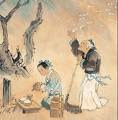
Sunday, April 5, 2009
Today, April 5th is a significant day in the tea world and a national holiday in China. It is the first day of the month "Qing Meng".
It is the day that families reunite and visit their ancestor's burial sites and clean them up, pray, offer fruits (always oranges, they represent good luck) and flowers and have a great time eating, getting caught up and drinking tea.
It is a significant day for China and the rest of the world because it is when the tea pickers are hired from all of the surrounding villages and tea picking is started in earnest. Often the rains have subsided and the freshest, richest and largest tea buds of the season are harvested during the fifteen day month of Qing Meng. The prices also reflect the desirability of the tea harvested in this time frame; it is much more expensive.
The farmers work with a twenty four season calendar, each season lasting about 15 days. The season that preceded Qing Meng is called Jin Zhe, which means "spring thunder" and is an apt description of the rainy days we have been traveling through prior to Qing Meng. The next 15 day month after Qing Meng is called Gu Yu and the quality and the price of the tea remains high through this month also. After Gu Yu, the tea is considered less desirable, still wonderfully drinkable, but certainly less expensive. Freshness counts as does the month your tea was picked in.
Incidentally, the reason we were interviewed three times by television stations in China was because Qing Meng was coming up and they were pre-recording footage for broadcast today. So, in visiting what are considered extremely small, remote, hand- crafted tea producers still run by family trained tea masters they were quite amazed to find us, the westerners. They were also quite pleased: it gave their stories a different angle and proved a not-so subtle point the broadcasters were trying to make. That point was that modern Chinese are losing their appreciation and interest in the art of hand -crafted teas.With Westerners like us enjoying, studying and being very appreciative of their native gift to the world, it helped to prove their point.
I have a confession to make at this point. While it is April 5 in the Western Hemisphere, it is not in the the country of China. China is at least 15 hours ahead of the Western Hemisphere.
Drink your old tea and prepare to pick up some fresh tea plucked during Qing Meng and Gu Yu. It is worth the price.
Andy
Today, April 5th is a significant day in the tea world and a national holiday in China. It is the first day of the month "Qing Meng".
It is the day that families reunite and visit their ancestor's burial sites and clean them up, pray, offer fruits (always oranges, they represent good luck) and flowers and have a great time eating, getting caught up and drinking tea.
It is a significant day for China and the rest of the world because it is when the tea pickers are hired from all of the surrounding villages and tea picking is started in earnest. Often the rains have subsided and the freshest, richest and largest tea buds of the season are harvested during the fifteen day month of Qing Meng. The prices also reflect the desirability of the tea harvested in this time frame; it is much more expensive.
The farmers work with a twenty four season calendar, each season lasting about 15 days. The season that preceded Qing Meng is called Jin Zhe, which means "spring thunder" and is an apt description of the rainy days we have been traveling through prior to Qing Meng. The next 15 day month after Qing Meng is called Gu Yu and the quality and the price of the tea remains high through this month also. After Gu Yu, the tea is considered less desirable, still wonderfully drinkable, but certainly less expensive. Freshness counts as does the month your tea was picked in.
Incidentally, the reason we were interviewed three times by television stations in China was because Qing Meng was coming up and they were pre-recording footage for broadcast today. So, in visiting what are considered extremely small, remote, hand- crafted tea producers still run by family trained tea masters they were quite amazed to find us, the westerners. They were also quite pleased: it gave their stories a different angle and proved a not-so subtle point the broadcasters were trying to make. That point was that modern Chinese are losing their appreciation and interest in the art of hand -crafted teas.With Westerners like us enjoying, studying and being very appreciative of their native gift to the world, it helped to prove their point.
I have a confession to make at this point. While it is April 5 in the Western Hemisphere, it is not in the the country of China. China is at least 15 hours ahead of the Western Hemisphere.
Drink your old tea and prepare to pick up some fresh tea plucked during Qing Meng and Gu Yu. It is worth the price.
Andy


